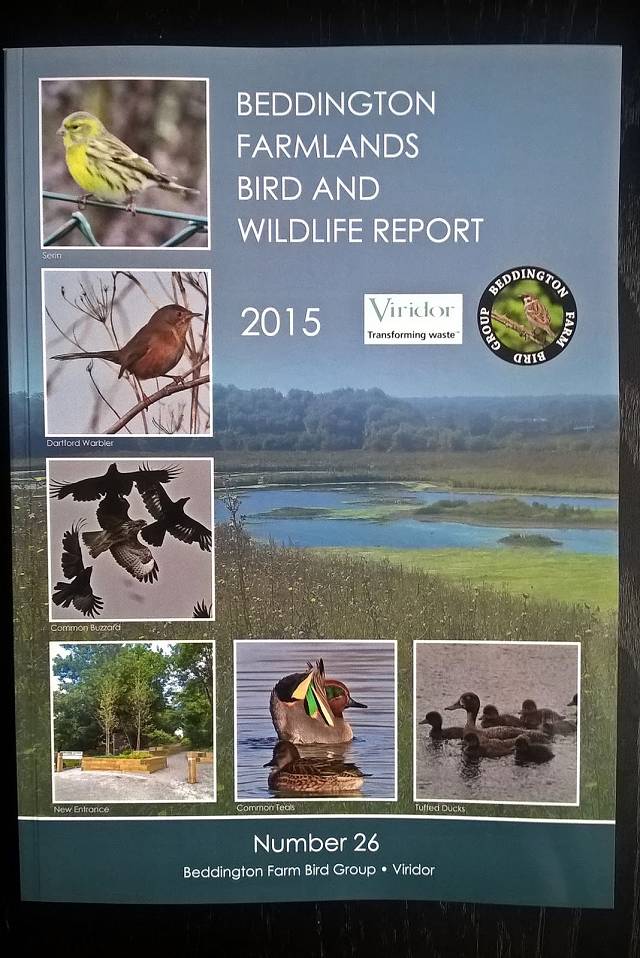Beddington Farmlands Bird and Wildlife Report 2015
 With around 7,000 bird reports in my collection I can confidently say that it is quite rare to see an A4-sized bird report these days, but that's exactly what we have with this impressively large format, colour-print wildlife report, which runs to 135 pages and 71 photographs — including 14 half-page photographs of moths.
With around 7,000 bird reports in my collection I can confidently say that it is quite rare to see an A4-sized bird report these days, but that's exactly what we have with this impressively large format, colour-print wildlife report, which runs to 135 pages and 71 photographs — including 14 half-page photographs of moths.
Lying along the Wandle valley in Croydon, Beddington is a well-known site in Greater London. The report is produced by the Beddington Farm Bird Group and is sponsored by the site owners, Viridor Waste Management. Of the birds, some 163 species were recorded during the year, albeit four of these were either not submitted or considered 'not proven'. One new bird seen and photographed for the site was European Serin, which brought the site list up to 258. Breeding highlights included a record 75+ fledged Tufted Duck young and the first successful breeding of Great Crested Grebe. On the downside, only two pairs of Tree Sparrows bred in 2015 — Beddington formerly held one of the largest colonies in Britain, with 80 pairs as recently as 2010.
Early pages describe the Aims and Objectives of the BFBG, the BFBG Rare Bird Policy, Recording Methodology (data sources) and a Restoration Update 2015, all of which point to a complex and presumably delicate working arrangement, with a host of surveys continually being undertaken by either BFBG or MKA Ecology Ltd (as commissioned by Viridor). The Restoration Update gives a flavour of how difficult it can be for the local bird group, with mention of a new incinerator proposal, a campaign to stop the incinerator, councils, the local government ombudsman and so on. In late 2015, Viridor cut the number of bird group key holders from 30 to 15 (citing health & safety concerns) but subsequently increased this to 25.
With so few observers (26 listed for 2015) the report must be regarded as quite an achievement. The main section includes a monthly summary, followed by the Systematic List. The latter makes good use of the ample space available, with the regularly occurring species having a monthly maxima table plus brief comments while less common species have each sighting noted. Colour photographs are embedded within the species accounts and eight very clear graphs show interesting annual trends, such as Lapwing territories and wintering Water Pipit numbers. However, I do think the species accounts would benefit from a brief comment/indication of status e.g. breeding, past-breeder and son, as some species are presumably breeding but not covered in the breeding surveys (such as Woodpigeon, Magpie and House Sparrow).
Sections include a Ringing Report and the Breeding Bird Survey 2015 results, which includes a detailed tabulation of counts and comparisons with 2012–14, plus an interesting discussion on how different observers can produce different results! A 19-page Bird Population Monitoring report shows trends since 1995 for 11 target species, chosen to be indicators for the Conservation Management Plan. Because of delays or only partial restoration being undertaken, breeding pairs for some eight of the 11 species are in a dire state (extinct, near-extinct or failed). Trends are also shown for a further 25 indicator species in different habitat types.
Further papers include notes on ringed gulls, other wildlife (butterflies, moths), systematic lists with status notes for butterflies and dragonflies, and a note on mustelids. A graph (p. 125) shows the number of 'bat passes per visit' since 1999 but gives no indication of the species' involved and no narrative by way of explanation.
Four useful site maps show different aspects of the site, though one or two have not reproduced very well, showing blurred text in the keys.
To summarise, this is an interesting report covering what is clearly a complex site. The report will certainly add to the information database and be hugely useful for reference purposes when restoration is implemented more fully in the future. Copies can be obtained from the editor, Peter Alfrey, via bfnr.org.uk/publications.
Peter also adds that any local birding groups wanting a template of the report for their own reports (Tice's Meadow use this template now too) should please email him for a copy.

